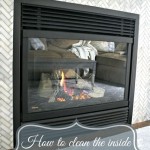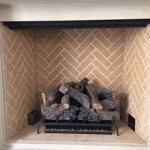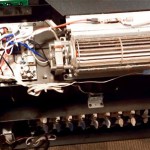The Persistent Odor: Understanding Smell From Unvented Gas Fireplaces
Unvented gas fireplaces, also known as vent-free gas fireplaces, offer a convenient and often aesthetically pleasing heating solution for many homes. However, a common complaint associated with these appliances is the presence of an unpleasant odor. Identifying the source of this smell and understanding its potential causes is crucial for ensuring both comfort and safety within the living environment. The odor emanating from an unvented gas fireplace is generally indicative of incomplete combustion or the presence of impurities, either in the fuel supply or within the fireplace itself. This article delves into the various factors that contribute to this issue, exploring potential causes and offering guidance on how to mitigate the unwanted smell.
The fundamental principle of an unvented gas fireplace is to burn natural gas or propane directly within the living space, without the need for a chimney or external venting system. This process inherently introduces byproducts into the air, including water vapor, carbon dioxide, and, if combustion is not complete, potentially harmful gases like carbon monoxide. While modern unvented gas fireplaces are designed with safety features such as oxygen depletion sensors (ODS) that shut off the gas supply if oxygen levels become dangerously low, the presence of an odor suggests a malfunction or an issue that needs addressing.
The odor typically associated with an unvented gas fireplace is often described as a stale, slightly acrid, or even sulfurous smell. The intensity and specific characteristics of the odor can vary depending on the underlying cause. It is important to note that any persistent or unusual smell emanating from a gas appliance should be taken seriously, as it could indicate a potentially hazardous situation.
Understanding the Potential Causes of the Odor
Several factors can contribute to the presence of an odor from an unvented gas fireplace. These factors can be broadly categorized into issues related to incomplete combustion, contaminants in the fuel supply, and problems with the fireplace appliance itself.
Incomplete combustion occurs when the gas is not fully burned during the combustion process. This leads to the production of various byproducts, including carbon monoxide, formaldehyde, and other volatile organic compounds (VOCs). These compounds often have a distinct odor that can be detected in the living space. Several factors can contribute to incomplete combustion. Insufficient oxygen supply to the burner can be a primary cause. This can occur if the fireplace is located in a poorly ventilated room or if the air inlets to the burner are blocked or obstructed. Incorrect gas pressure can also lead to incomplete combustion. If the gas pressure is too low, the flame may not burn efficiently, resulting in the release of uncombusted gases. Dirty or malfunctioning burners can also contribute to the problem. Over time, the burner ports can become clogged with dust, debris, or carbon deposits, which can disrupt the gas flow and lead to incomplete combustion. Finally, improper adjustment of the air-to-fuel mixture can significantly affect combustion efficiency. The ideal ratio of air to fuel is critical for complete combustion, and any deviation from this ratio can result in the production of odorous byproducts.
Contaminants within the gas supply can also contribute to the odor emanating from an unvented gas fireplace. Natural gas and propane are typically odorized with a sulfur-containing compound called mercaptan to allow for easy detection of leaks. While this odorant is normally harmless, it can become more noticeable and potentially unpleasant if the gas is not burning completely or if there are issues with the fireplace itself. Additionally, trace amounts of other contaminants may be present in the gas supply, depending on the source and processing of the fuel. These contaminants can contribute to the overall odor profile of the fireplace. In some cases, the odor may be due to a leak somewhere in the gas line, even a very small one. Even with the mercaptan, a tiny leak may not be immediately apparent until the smell accumulates over time. It's crucial to rule out gas leaks when investigating unusual odors near any gas appliance.
Problems with the fireplace appliance itself can also generate odors. New fireplaces often emit a "burning off" smell during their initial use. This is due to the burning of manufacturing oils, dust, and other residues that are present on the components of the fireplace. The smell typically dissipates after a few hours of operation. However, if the smell persists, it could indicate a more serious issue. Dust and debris that accumulate on the burner, logs, or other components of the fireplace can burn and generate a noticeable odor. Pet dander, dust mites, and other allergens can circulate within the fireplace and contribute to the problem. Malfunctioning or damaged components within the fireplace, such as the gas valve, pilot light assembly, or oxygen depletion sensor, can also cause the unit to operate improperly and emit an odor. If the fireplace has been recently serviced or repaired, improper installation of components or the use of incompatible parts can also contribute to the problem.
Addressing the Odor: Diagnostic and Remedial Steps
When addressing an odor emanating from an unvented gas fireplace, a systematic approach is crucial for accurately diagnosing the cause and implementing effective solutions. The following steps outline a process for identifying and mitigating the odor.
Begin by thoroughly inspecting the fireplace for any visible signs of damage, dirt, or debris. Clean the burner ports, logs, and surrounding areas using a soft brush or vacuum cleaner. Ensure that the air inlets to the burner are clear and unobstructed. Check the gas line and connections for any signs of leaks. A soapy water solution can be used to identify leaks. Apply the solution to the connections and look for bubbles. If a leak is detected, immediately shut off the gas supply and contact a qualified technician.
Verify that the fireplace is properly adjusted and calibrated. Check the gas pressure and adjust as needed according to the manufacturer's instructions. Inspect the pilot light and ensure that it is burning with a strong, blue flame. If the flame is yellow or orange, it indicates incomplete combustion. Adjust the air-to-fuel mixture to optimize combustion efficiency. This may require the assistance of a qualified technician. Consider having the fireplace professionally inspected and serviced by a qualified technician. A technician can perform a thorough inspection of the appliance, identify any underlying problems, and make necessary repairs or adjustments. They can also check the carbon monoxide levels in the room to ensure that the fireplace is operating safely. If the odor persists after cleaning and adjusting the fireplace, consider the possibility of contaminants in the gas supply. Contact the gas company and request an inspection of the gas line and meter. They can check for leaks and identify any potential problems with the gas supply. In addition, ensure adequate ventilation in the room where the fireplace is located. Open windows or doors to allow for fresh air circulation. This can help to dilute any odors and improve the overall air quality in the room.
Consider the age of the fireplace. If the fireplace is old, it may be more prone to problems and may require replacement. Newer models are often more efficient and produce fewer emissions. If the fireplace continues to emit a strong odor despite these measures, it may be necessary to discontinue its use until the problem can be resolved by a qualified technician. Continuing to operate a fireplace that emits a strong odor could pose a safety risk.
The Importance of Professional Assistance and Maintenance
While many basic troubleshooting steps can be performed by homeowners, the complexity of unvented gas fireplaces often necessitates the involvement of a qualified technician. Attempting to repair or modify a gas appliance without proper training and experience can be dangerous and could potentially lead to gas leaks, explosions, or carbon monoxide poisoning. Technicians are equipped with specialized tools and knowledge to diagnose and repair a wide range of issues, ensuring the safe and efficient operation of the fireplace.
Regular maintenance is also crucial for preventing odors and ensuring the longevity of the fireplace. Schedule annual inspections and servicing by a qualified technician. This includes cleaning the burner, checking the gas pressure, inspecting the pilot light, and testing the oxygen depletion sensor. Professional maintenance can help to identify and address potential problems before they become more serious and can extend the lifespan of the fireplace. Proper maintenance practices also align with the manufacturer's recommendations, ensuring compliance with warranty requirements and maximizing the appliance's performance. Ignoring recommended maintenance can void warranties and potentially lead to costly repairs in the future. Document all maintenance work performed and retain records for future reference. This can be helpful in tracking the performance of the fireplace and identifying any recurring issues.
In conclusion, addressing the odor from an unvented gas fireplace often involves a multifaceted approach, combining diligent inspection, cleaning, and professional maintenance. The goal is to ensure safe and efficient operation while maintaining a comfortable and healthy indoor environment. It should be reiterated, any persistent or unusual odor warrants immediate attention and should not be ignored. Prioritize safety and seek professional assistance when necessary to guarantee the proper functioning and safe operation of the unvented gas fireplace.

Vent Free Fireplace Odor

Vent Free Fireplace Odor

Ventless Gas Fireplace Maintenance Guide Fireplaces Direct Learning Center

Ventless Gas Fireplace Maintenance Guide Fireplaces Direct Learning Center

Gas Fireplace Insert Smells Like Burning Plastic Fix It Now Upgradedhome Com

Does Ventless Gas Fireplace Smell Safe Or Not Cottage Fires

Why Do My Gas Logs Smell Foster Fuels

Vent Free Gas Logs What S That Smell
I Have A Gas Fireplace In My Living Room When Use It There Is An Exhaust Smell The House Vent Clean What Else Should Troubleshoot To Fix

ᑕ❶ᑐ Ventless Gas Fireplace Insert Disadvantages Of Use
Related Posts








